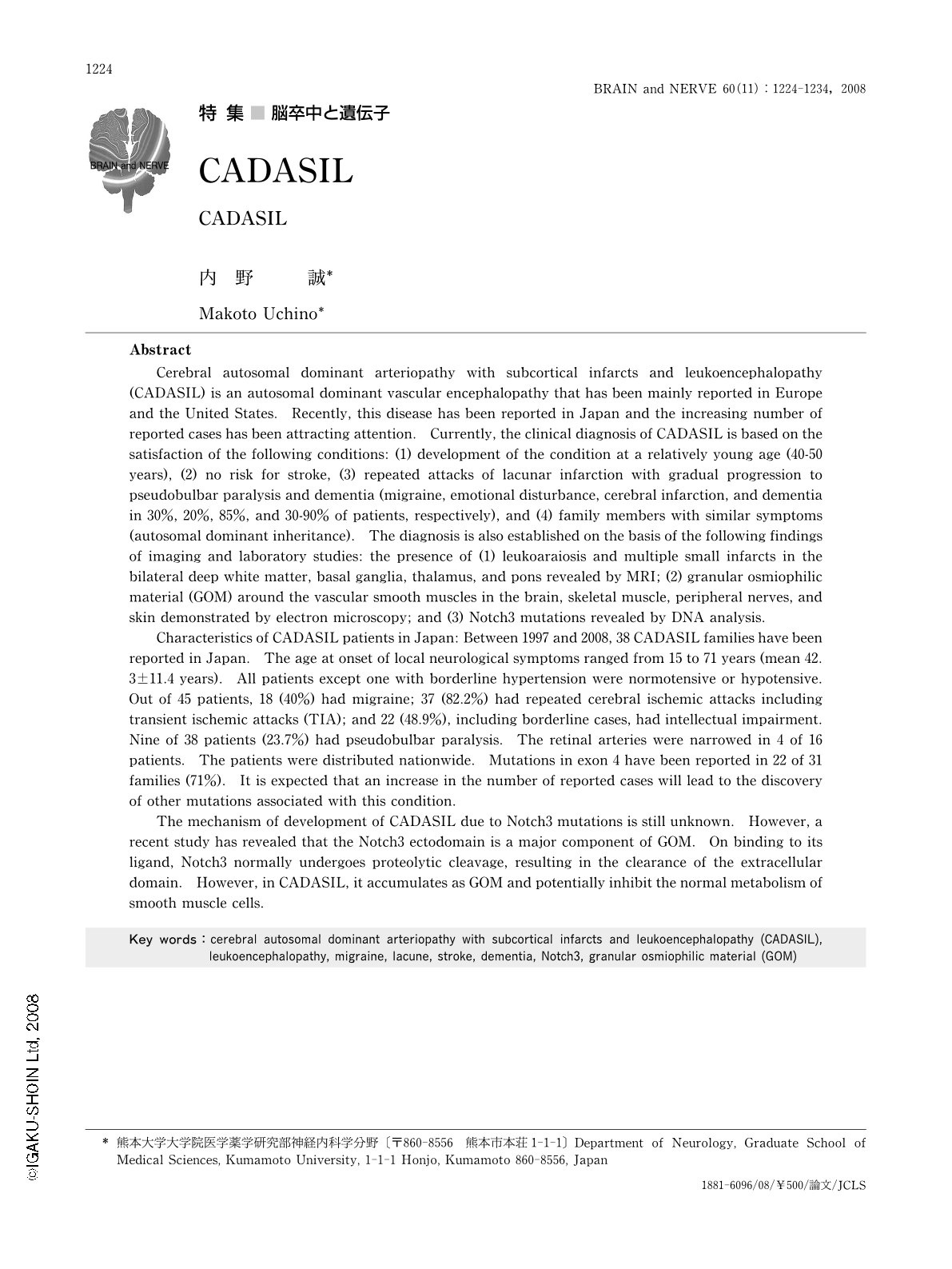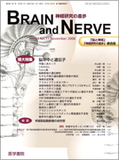Japanese
English
- 有料閲覧
- Abstract 文献概要
- 1ページ目 Look Inside
- 参考文献 Reference
はじめに
脳卒中は不適切な生活習慣(高カロリー食・塩分過多,運動不足,喫煙,大量飲酒,睡眠不足など)により惹起される生活習慣病(肥満,高血圧,耐糖能異常,高脂血症,高尿酸血症など)を主要な危険因子として,加齢などの要因も加わって発症に至る環境要因の関与が大きい疾患とされてきたが,近年分子遺伝学的研究の進歩とともに,脳卒中の発症に脳卒中感受性遺伝子(遺伝子多型)の関与も少なくないこと,さらに環境要因が関与しない単一遺伝子異常に基づく遺伝性の脳卒中の存在も次々に明らかになってきている(Table1)1)。
CADASIL(cerebral autosomal dominant arteriopathy with subcortical infarct and leukoencephalopathy)はそのような遺伝性脳卒中の1つであり,日本語では皮質下梗塞と白質脳症を伴う常染色体優性遺伝性脳動脈症と訳される。最初にTournier-Lasserveらが,2家系の連鎖解析で19q12に原因遺伝子の局在を証明し,CADASILと命名した2)。その後JoutelらによりNotch 3遺伝子が病因遺伝子であることが明らかにされ,遺伝子座は19p13.1~13.2に訂正された3)。Notch 3はヒトで4種類知られているNotch型受容体の1つで,全身の血管平滑筋細胞の形質膜に局在し,細胞外ドメインでリガンドと結合して情報伝達に関与すると考えられるが,詳しい機能はわかっていない。欧米を中心に400家系以上の報告があるが,近年わが国でもその報告が増しており,人種を越えて存在する疾患と考えられる。
Abstract
Cerebral autosomal dominant arteriopathy with subcortical infarcts and leukoencephalopathy (CADASIL) is an autosomal dominant vascular encephalopathy that has been mainly reported in Europe and the United States. Recently,this disease has been reported in Japan and the increasing number of reported cases has been attracting attention. Currently,the clinical diagnosis of CADASIL is based on the satisfaction of the following conditions: (1) development of the condition at a relatively young age (40-50 years),(2) no risk for stroke,(3) repeated attacks of lacunar infarction with gradual progression to pseudobulbar paralysis and dementia (migraine,emotional disturbance,cerebral infarction,and dementia in 30%,20%,85%,and 30-90% of patients,respectively),and (4) family members with similar symptoms (autosomal dominant inheritance). The diagnosis is also established on the basis of the following findings of imaging and laboratory studies: the presence of (1) leukoaraiosis and multiple small infarcts in the bilateral deep white matter,basal ganglia,thalamus,and pons revealed by MRI; (2) granular osmiophilic material (GOM) around the vascular smooth muscles in the brain,skeletal muscle,peripheral nerves,and skin demonstrated by electron microscopy; and (3) Notch3 mutations revealed by DNA analysis.
Characteristics of CADASIL patients in Japan: Between 1997 and 2008,38 CADASIL families have been reported in Japan. The age at onset of local neurological symptoms ranged from 15 to 71 years (mean 42.3±11.4 years). All patients except one with borderline hypertension were normotensive or hypotensive. Out of 45 patients,18 (40%) had migraine; 37 (82.2%) had repeated cerebral ischemic attacks including transient ischemic attacks (TIA); and 22 (48.9%),including borderline cases,had intellectual impairment. Nine of 38 patients (23.7%) had pseudobulbar paralysis. The retinal arteries were narrowed in 4 of 16 patients. The patients were distributed nationwide. Mutations in exon 4 have been reported in 22 of 31 families (71%). It is expected that an increase in the number of reported cases will lead to the discovery of other mutations associated with this condition.
The mechanism of development of CADASIL due to Notch3 mutations is still unknown. However,a recent study has revealed that the Notch3 ectodomain is a major component of GOM. On binding to its ligand,Notch3 normally undergoes proteolytic cleavage,resulting in the clearance of the extracellular domain. However,in CADASIL,it accumulates as GOM and potentially inhibit the normal metabolism of smooth muscle cells.

Copyright © 2008, Igaku-Shoin Ltd. All rights reserved.


